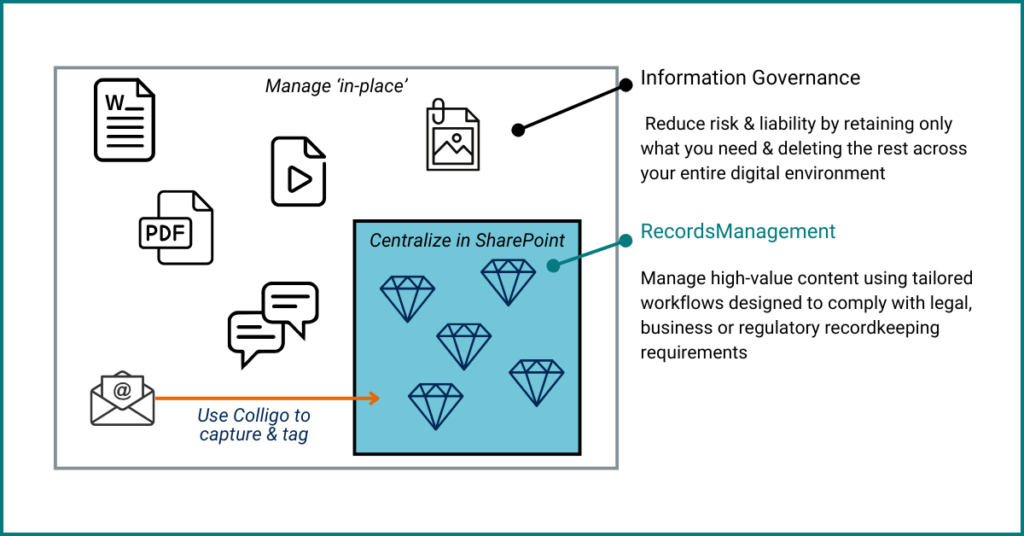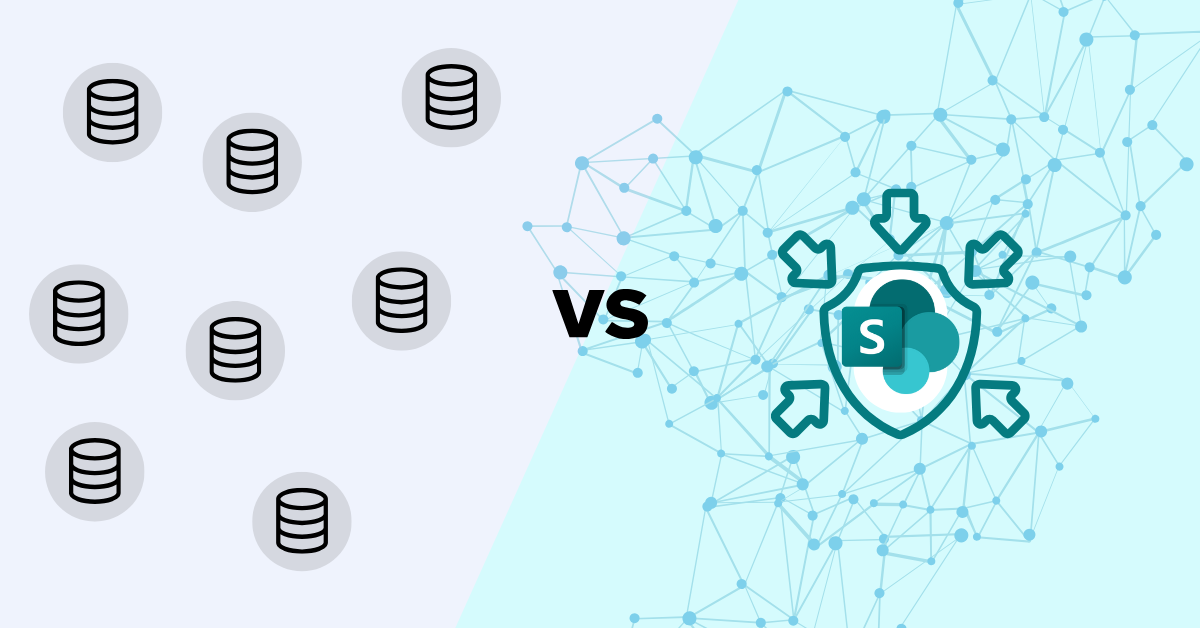Last Updated on January 16, 2025 Sarah Gayda
It’s Time to Rethink In-Place Records Management & Opt for a Centralized Model for Business Success
The concept of managing records “in-place” has sparked long-standing debate within the information governance community. What does “in-place” really mean, and is it the right approach for your organization? The answer is not as straightforward as it might seem because interpretations vary widely. Even industry leaders like Microsoft have evolved their definitions over time.
At the heart of this debate lies a crucial question: Should businesses focus on managing records “in-place” or adopt a more comprehensive compliance and business success model? We believe the latter is the key to both meeting regulatory requirements and driving operational success.
Before we dive into the specifics of what this model looks like, it’s important to unpack the confusion surrounding “in-place” records management. What are its implications, and why do its interpretations vary so much? Let’s begin by establishing a few key definitions to clarify the conversation.
The Changing Definition of “In-Place” Records Management
To clarify the terminology, when we discuss “in-place” records management, we’re referring to a model where records are left in the location where they are created or captured, rather than being moved to a centralized repository or system of record, such as SharePoint.
It’s worth noting that some refer to moving records to SharePoint as an “in-place” model. This reflects the original Microsoft approach, which involved separating records from non-records and storing them in SharePoint.
While this historical definition of “in-place” aligns with compliance standards like DOD5015.2, it’s not the version of “in-place” we’re debating here. In fact, we advocate for the approach of centralizing and storing in records SharePoint (or Teams), as it supports centralized management and compliance.
However, the conversation has shifted. Today, when the industry talks about “in-place” records management, it often refers to a more distributed model. This means a system where records are managed across the multiple locations where they’re created or captured, without consolidation into a centralized repository. We do not find this distributed approach to be compliant or efficient.
Now that we’ve untangled the evolving definitions of ‘in-place’ records management, it’s time to focus on what really matters: why a centralized approach to managing records is the key to achieving both compliance and business success.

Best Practice: Centralize Records in SharePoint to Enhance Compliance & Collaboration
Centralizing records management offers five critical benefits for organizations:
1. Streamlined Access
- Centralizing records creates a single, reliable location for important business documents like agreements, contracts, invoices, and standard operating procedures.
- Users can focus on finding what they need without worrying about where it’s stored, reducing time spent searching for information.
2. Enhanced Control
- Moving records like invoices or purchase orders into a dedicated SharePoint folder with default retention policies ensures they automatically inherit the correct rules.
- Original email copies can remain in systems like Outlook under broader, blanket retention policies (e.g., a two-year policy), offering both control and flexibility.
3. Reduced Silos and “Dark” Repositories
- Centralized records management minimizes the risks associated with isolated, unorganized repositories, making information easier to manage, find, and govern effectively.
- Centralized records management offers a clean storage repository where only valuable business information is kept. Redundant, outdated or trivial data is not stored here.
4. Improved Collaboration and Knowledge Sharing
- Centralized platforms like SharePoint Online or Teams allow team members to access and work with documents seamlessly.
- Metadata capabilities in these systems boost efficiency and deliver long-term value, especially as organizations leverage AI for advanced workflows (see our AI Metadata blog post for more).
5. Regulatory Compliance
- For regulated industries, centralization is critical. Regulatory records often require separation from other data, along with strict retention policies for long or indefinite periods.
- A centralized model ensures compliance by maintaining clear, controlled access and retention processes.
Why Modern “In-Place” Records Management Model Falls Short
While the idea of managing records “in-place” may seem appealing, this modern approach has several drawbacks:
- Assumes Incomplete Record Management – The model starts from the assumption that it’s impossible to capture and manage all records comprehensively. This notion simply doesn’t hold up with today’s advanced tools and technologies.
- Non-Compliant Retention Labels – It often applies broad, generic retention labels to records that require more specific, document-type-based retention rules. This can lead to non-compliance with regulatory requirements.
- Reliance on Dynamic System Data – This approach frequently relies on system-generated data, such as modification dates, rather than capturing a fixed, “point-in-time” version. For example, in emails, it may use modified dates instead of sent or received dates, which undermines accurate recordkeeping.
- Limited Metadata Capabilities – Microsoft’s modern in-place approach lacks the ability to add metadata when declaring or designating a record. Metadata is crucial for managing records effectively and retrieving information efficiently. Fortunately, solutions like Colligo can overcome this limitation. (More on that at the end of this article!)
So, given all the attention being paid to “in-place”, when does the modern “in-place” method make sense? In our view, if your organization is not regulated and has nothing in place for managing records. This model is still better than having nothing in place and can often be a starting point for those newer to implementing compliance and governance.
Colligo’s Recommendation: Combine the Best of Both Worlds
At Colligo, we recommend centralizing records into SharePoint Online while leveraging certain advantages of the modern “in-place” model, such as defining scalable labels in Compliance Center and using regulatory records/immutable labels.
This approach strikes the perfect balance: bringing records from their points of creation or receipt into a centralized system of record (SharePoint Online) and managing them as proper records within this repository.
For effective information governance and compliance, it’s essential to determine when to use retention policies, labels, or both. One approach is to remove users from decision-making altogether by having documents inherit policies based on their saved location—a method with considerable merit.
Alternatively, a hybrid approach uses location-based policies for sites and document-specific labels for unique retention needs. For E3 Office license clients, labels alone are also a viable option.
Regardless of your preferred strategy, Colligo can support your organization by simplifying compliance. Whether you need tools to apply labels or enforce automatic policy inheritance for emails and attachments, we make it easy to implement the right governance model for your business.
Ready to streamline your information governance? Contact us to learn how Colligo can help.


